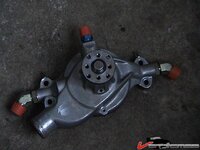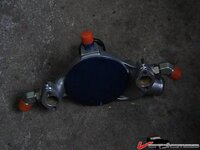External Plumbing
Street-driven vehicles seldom need auxiliary plumbing or coolant lines. SBC race engines with aluminum cylinder heads usually require extensive external plumbing to address two design problems:
1. Aluminum heads have much smaller water jackets than cast-iron heads because the external dimensions are similar, but the ports are usually larger, the deck is thicker, and the material near the rocker stands is thicker, all leaving less area in the water jackets. This decreased internal area leaves less area in the water jackets.
2. The siamese center exhaust ports are a design compromise that presents additional problems when aluminum heads are used. The area near the center exhaust valves is thicker, thus allowing providing less surface area for cooling.
We recommend installing a pair of –10 AN lines that connect the rear of the aluminum cylinder heads to the thermostat housing crossover in the front. This step will help offset the smaller water jackets. A pair of -10AN lines connecting the pressure side of the water pump with the area in the center of the cylinder head (just below the exhaust ports) will offset the lack of surface area due to the extra material.


